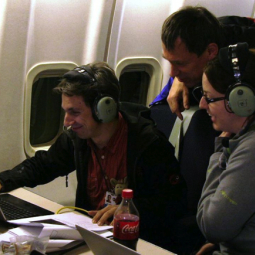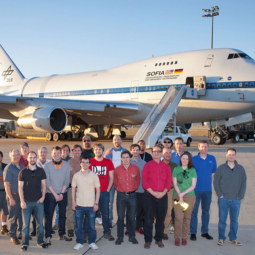The scientific capabilities of NASA’s Stratospheric Observatory for Infrared Astronomy (SOFIA) were increased substantially on April 15, 2014, with completion of commissioning tests and the first scientific observations made by the Field-Imaging Far-Infrared Line Spectrometer, FIFI-LS.
Alfred Krabbe from the Institute of Space Systems, University of Stuttgart, Germany, led the team that developed FIFI-LS. The University of Stuttgart is home to the German SOFIA Institute (DSI) that coordinates the German portion of SOFIA’s scientific operations on behalf of NASA and the German Aerospace Center (DLR). Krabbe's team delivered FIFI-LS in November 2013 to the observatory's home base at the Armstrong Flight Research Center's scientific aircraft operations facility in Palmdale, Calif. During the following months, the team made final adjustments and completed ground testing before the instrument took to the skies on board SOFIA beginning in March.
FIFI-LS was first used to study the Orion Nebula, a massive star-forming region located 1,300 light years from Earth. The dense gas within that nebula is condensing to form hundreds of stars including the Becklin-Neugebauer (BN) object, an especially luminous protostar.
For stars to form, relatively warm gas in the nebula must cool from about 100 degrees K (minus 280 degrees F) to about 10 degrees Kelvin (minus 440 degrees F). Only then does the pressure inside the cloud decrease and the gas density increase sufficiently to allow the star formation process to commence. Atoms of elements such as oxygen and carbon can drive this cooling process by radiating thermal energy from inside the cloud toward the outside.
FIFI-LS co-developer and the Orion observations' principal investigator Leslie Looney from the University of Illinois is studying the BN region to learn more about how these cooling processes work. “Oxygen and carbon emit a considerable amount of the cloud’s thermal energy at wavelengths which can be observed using FIFI-LS on SOFIA,” Looney said. SOFIA is currently the only ground- or space-based observatory that can receive cosmic radiation at these far-infrared wavelengths.
In competition with that cooling process, a cluster of four hot stars in the Orion Nebula, known as the Trapezium, heat the gas cloud. When heated gas collides with cooler gas, a shock wave such as the Orion Bar can occur (see Figure 1). From the strength and spatial distribution of emission from neutral oxygen (OI – observed at 63 and 145 microns) and singly ionized carbon (CII – observed at 157 microns), astronomer Looney can investigate the detailed relation between the nebular cooling and heating mechanisms. He noted, “An outstanding aspect of the FIFI-LS data is the size of the map at this fine resolution.”
Astronomer and instrument builder Krabbe said, “I am really happy that FIFI-LS worked so well with the SOFIA observatory and that we can now provide a new scientific instrument to the astronomical community. For the next observing cycle that will start in spring 2015, the team plans to make additional observations of Orion in order to complete the existing maps."
SOFIA is a joint project of NASA and the German Aerospace Center (DLR). The aircraft is based at the NASA Armstrong Flight Research Center’s facility in Palmdale, Calif. NASA Armstrong Flight Research Center manages the program. NASA Ames Research Center at Moffett Field, Calif., manages the SOFIA science and mission operations in cooperation with the Universities Space Research Association (USRA) headquartered in Columbia, Md., and the German SOFIA Institute (DSI) at the University of Stuttgart.


